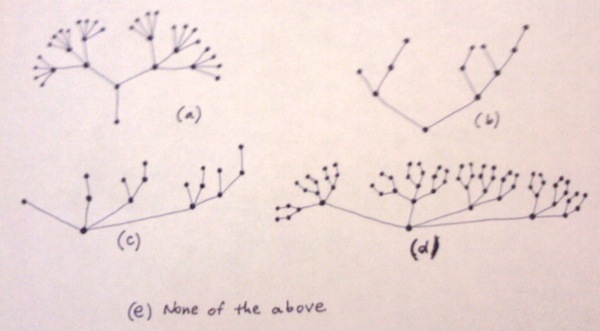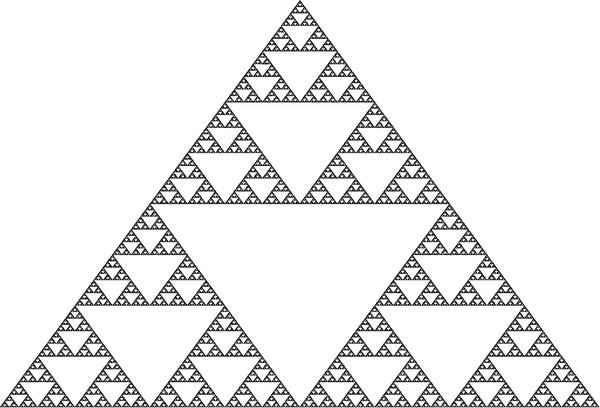Simply circle the best answer for each question. You'll receive +5 points for each question answered correctly and -1 point for each question answered incorrectly. Circling more than one answer for a problem will get you -25 — don't do this!
- How can we encode the statement "All Italians will eventually be rich"?
- ∀x:<Ix⊃G(x=r)>
- F∀x:<Ix∧Rx>
- ∀x:<Ix⊃FRx>
- G∀x:<Ix⊃Rx>
- None of the above
- Which of the following are true about the material implication <A⊃B>?
- It is false precisely when A is false and B is true
- It is true when B is true
- It is true when A is true and B is false
- A causes B
- None of the above
- Gödel's First Incompleteness Theorem states that any classical, bivalent,
logistic system capable of formalizing arithmetic on natural numbers must be:
- Sound but not complete
- Inconsistent or incomplete
- Unable to prove all of its theorems
- Incapable of capturing intuitive truths about the natural numbers
- All of the above
- Why has Searle been considered a critic of strong artificial intelligence?
- He says that minds are caused by brains and are not the result of simple symbol-manipulation
- He finds the hard problem of consciousness unsolvable
- He rejects the notion that mental phenomena is caused by processes in the brain
- All of the above
- None of the above
- Which of the following would Searle assert about his Chinese Room?
- It is a better model for mechanized thought than the Turing Test
- The guy in the room doesn't understand Chinese, but the room does
- It shows that consciousness is illusory
- All of the above
- None of the above
- Here is a formal system I just made up.
Which of the following is not a theorem of the system?- B is a theorem.
- if x is a theorem, then so is AxA.
- Inside of any theorem, AA can be replaced with a C to produce a new theorem.
- CABAC
- CABCA
- ABCC
- CCCBACCA
- AAACAAAABCAACAC
- Suppose someone sent you the txt message "
6 R 1 R 5 L 3 R 1 R 4". What is the inner message here?- The arrangement of characters on your phone
- The letter L
- The number 14
- The combination to a safe
- The number 618118512.3181184
- Which of the following pictures implement the value B(4) given the following definition
of B? B(0) is a single dot. B(n) is a dot connected (via lines) to B(0), B(1), ..., and
B(n-1), repectively.

- In A Mu Offering, the five starting string positions are to axioms as strings
with Buddha-nature are to ___________ of TNT:
- Well-formed formulas
- Theorems
- True Statements
- Derivations
- Inference Rules
- In The Magnificrab, Indeed, the Crab manages to escape commenting
on or even playing Achilles's composition
∀a:∃b:∃c:<~∃d:∃e:<(SSd•SSe)=b∨(SSd•SSe)=c>∧(a+a)=(b+c)>. What was the reason for his discomfort and avoidance?- The square root of two is irrational and it is too hard to represent irrational numbers in TNT
- The Goldbach Conjecture is still an unsolved problem
- Truth and beauty are only isomorphic for computable functions
- All of the above
- None of the above
- Which of the following is a true statement about BlooP?
- Programs in BlooP are too hard for programmers to read
- Every BlooP program always terminates regardless of input
- BlooP programs illustrate both general and primitive recursion
- Every function on natural numbers can be computed by a BlooP program
- We can't decide whether they all terminate or not due to diagonalization
- Which of the following is a paradox?
I. A Cretan says, "All Cretans are liars"
II. A person says, "I am lying"
III. "quined is false" quined is false- I only
- I and III
- II and III
- I, II, and III
- II only
- Which of the following did Whitely use in his refutation of Lucas's apparent
ramblings on the superiority of mind over mechanized formal systems?
- The fact that the propositional calculus is not a hard-wired part of the brain
- Russell's paradox
- A demonstration that Lucas himself is just as incomplete as TNT
- Grelling's paradox
- The myth of self-transcendence
- Which of the following best describes the following recursive figure?

- The ground cannot be described formally
- It was discovered by a program designed to simulate goal-directed evolution
- It is made up of three copies of itself, each scaled down by a factor of 2 in both the horizontal and vertical dimensions
- It is made up of 9 copies of itself, each scaled down by a factor of 3 in both the horizontal and vertical dimensions
- It is a disconnected set of points
- Which of the following sentences can not be generated by the English subset
grammar we saw in class (repeated here)?
S → NP VP NP → (PN | DET ADJ* NOUN) (RP VP)? VP → IV | TV NP | DV NP PP | SV S PP → PREP NP PN → grace | donald | alan | she DET → a | the | his | her NOUN → doctor | dog | rat | girl | toy RP → who | that ADJ → blue | heavy | fast | new PREP → to | above | around | through IV → fell | jumped | swam TV → liked | knew | hit | missed DV → gave | threw | handed SV → dreamed | believed | thought | knew
- her fast new doctor that threw a toy above alan jumped
- the heavy fast blue rat knew she
- the dog swam around grace
- she handed the blue girl that believed a doctor hit she to a toy
- donald liked her new rat
- It is sometimes argued that no
deity can be simultaneously omnibenevolent, omniscient, and omnipotent because at most
two of the three are possible at once. We're interested not in discussing the origin
or merits of this claim but rather in symbolizing it. Call these three properties b, s, and
p, respectively. Which of the following states that all three cannot be true at the same time?
- <<p ∧ s> ⊃ ~b> ∧ <<p ∧ b> ⊃ ~s> ∧ <<s ∧ b> ⊃ ~p>
- <<p ∧ s> ∧ ~b> ∨ <<p ∧ b> ∧ ~s> ∨ <<s ∧ b> ∧ ~p>
- ~<<p ∨ b> ∨ s>
- All of the above
- None of the above
- Which of the following points were made by Hofstadter about the self-symbol in
the GEB chapter Minds and Thoughts?
- It is not qualitively different from other symtbols
- It would be highly unusual if it did not exist
- It is so complex as to be considered a subsystem
- Its constant interaction with other symbols, or monitoring of the symbols we have for symbols, resembles the sensation of what we call consciousness
- All of the above
- Even though Baum proposes and explains a theory to thought that in his words
"qualitively explain[s] everything about our consciousness and experience," he suspects
not all readers will be convinced with his (arguably mechanistic and physicalist)
picture, because:
- The hardware of the brain is finite
- We cannot prove that others are conscious
- The nature of qualitative experience is so gripping
- It is too complex — according to Occam's razor it should not take an entire book to explain
- The mind has evolved to "seal off" an acceptance of mechanistic explanations
- Which of the following claims were made by Baum regarding language?
- The capacity for language is located in an isolated module in the mind
- It evolved rapidly
- A hard-wired grammar is required for thought
- Meaning arises from the interaction between words
- It has an massive effect on our ability to communicate thoughts
- Which of the following illustrates a strange loop (or at least comes the closest)?
- Escher's Another World
- The sequence starting with 1 and in which each component (except the first) is one-half the value of the previous. (In other words, the sequence goes 1, 1/2, 1/4, 1/8, 1/16, ....)
- Alice is reading "Alice is reading"
- This exam has twenty questions
- 10, 9, 8, 7, 6, 5, 6, 7, 8, 9, 10